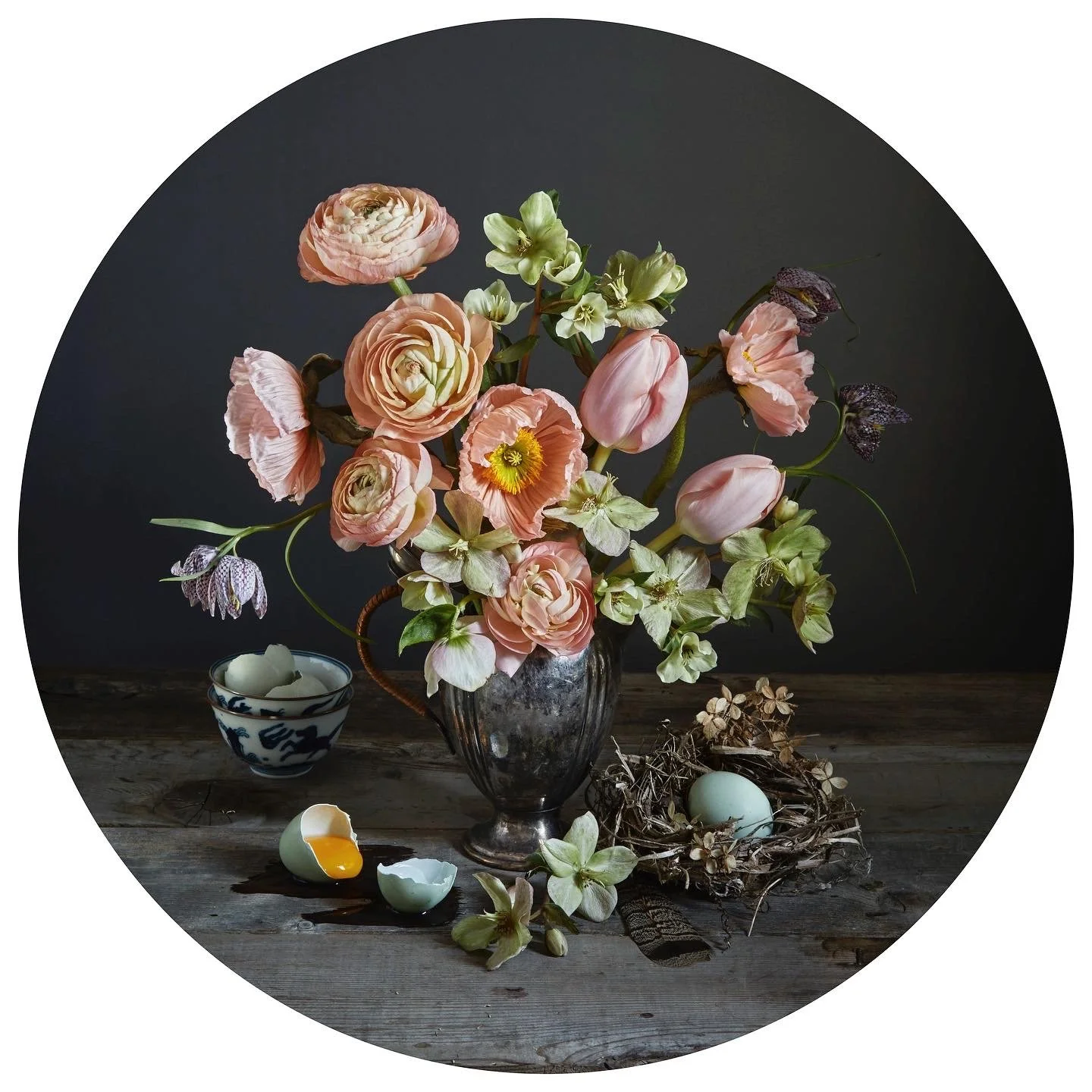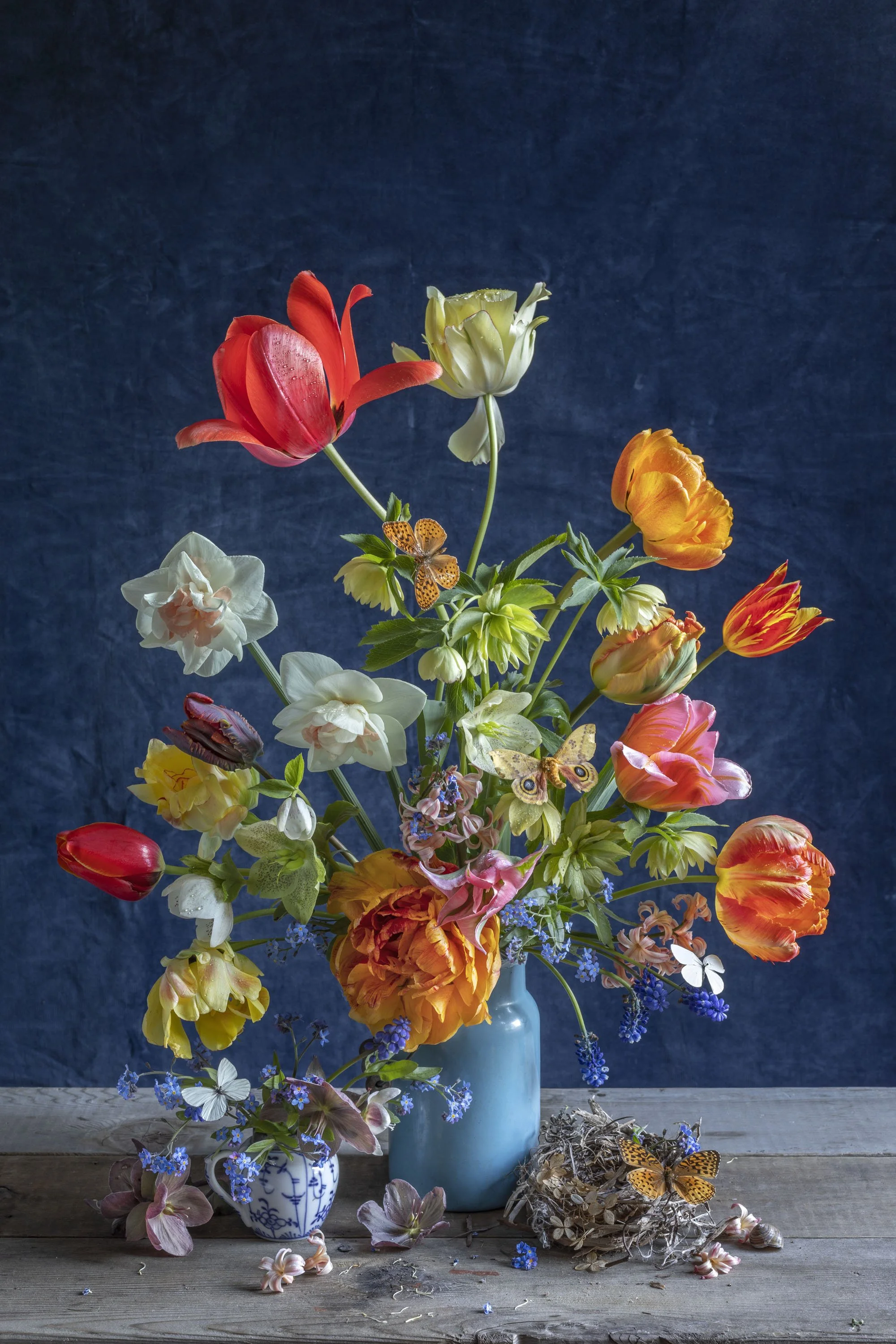An Interview With Kristin Sjaarda
From the moment I saw her work, I was instantly magnetized to Toronto-based artist Kristin Sjaarda’s pursuit of capturing the staggering beauty of our local ecology. Through the crafting of beguiling Dutch Master-like scenes using flowers from her own garden as well as those of nearby producers – plus found fauna and avian specimens from the Royal Ontario Museum – Sjaarda celebrates our habitat while also calling attention to its human-caused turmoil.
I was thrilled to hear that my avid art collecting dentist was having one of Sjaarda’s photos installed at her practice’s Studio, and it compelled me to finally ask her some things I’ve always wanted to know about her ravishing large-scale imagery. Read on to learn more about the evolution of Sjaarda’s oeuvre, and what she works on while the city's gardens take a well-deserved rest.
OPALOMA: Tell me about the evolution of your photographic practice since graduating from the The Colorado Institute of Art thirty years ago. How did you come to land on the subject matter and style of your photography?
KRISTIN SJAARDA: When my kids were little, I started setting up things that were close by, like hand-me-down objects from my Dutch immigrant parents, flowers that I had from my garden, and a few fruits. I started arranging those items beside the kitchen window as I was doing the things around the house that I needed to do.
As the arrangements got more elaborate, my husband urged me to use the professional camera and to try printing the image larger. It was a great way for me to mess around and try being creative, but I never thought it would come to much. Once I had printed them to that scale, and a few people had collected the prints, I got more curious about the Dutch still life paintings that I’ve been looking at in museums all my life. I started adding in things that I saw in the paintings, like bugs, that my kids found. Later, it was a collaboration with the ROM who lent me their birds that opened the door to the possibility of turning still life into an environment that included more interdependent species alongside the flowers.
Let's talk about the "ingredients" in your photos; where does this flora and fauna come from, and how do you select the things that make it into one of your compositions?
I sometimes use the flowers from my garden but also from local flower farmers, most of whom are women entrepreneurs and have farms where they grow pesticide-free flowers. As I became more aware of these farming practices, concern about sustainability was folded into my still life practice. By adding pollinators such as butterflies and bees, then birds who would feed on pollinators, then smaller fauna like coyote or raccoon skulls and so on up the food chain, the floral arrangements became more of an environment and a reflection of our our local ecosystem.
Some of my favourite photos of yours are from The Forest Floor series; tell me about those images and the inspiration behind them.
Every spring, as I am starting to get ready for a new year of gardening and art, there are bits of information that I gather sometimes by accident and sometimes on purpose. With The Forest Floor series, I had read an article on a painter from Amsterdam in the 1600s named Rachel Ruysch. She was a mother and a very successful painter and she liked to work in a genre called Sottobosco (undergrowth), where she painted not just the flowers, but also the ground where the petals would fall. There you will see bugs and snails, moss and fungus turning those petals into next year’s nourishment for plants. I was fascinated by that darker space and I started to add those elements into my own still life work.
Tell me about the challenges in working with natural elements. How have these challenges informed, or even changed your perception of what it means to have an artistic practice?
Yes, I have to work fast. I just have the amount of time that the flowers are fresh or slightly wilted when they’re starting to fall apart, but those flowers eventually get past a certain point and I’ve worked them too much. So sometimes I feel like I never get a still life perfectly right. I have to work with the shape of the stems or the wilt of the flowers. Knowing I only have a short amount of time to work with the flowers, I make sure that I do all my scavenger hunting for new props in the weeks before the shoot. And I know that while I’m shooting, I only have the daylight hours and when it gets too dark to see the set I have to quit.
What are your favourite flowers to photograph?
Every season I have a favourite flower. It’s hard to pick one. I try to use flowers that have a certain translucence and luminosity so that I can arrange them for the light to shine through the petals. It’s really satisfying to get a flower turned just right so that it looks like it glows.
Let's talk about the piece in Gelinas Dental Studio. What's the backstory, and tell me more about that incredible frame!
The work is part of my Circle Studies series, and it started as an off-shoot of the main still life photo shoot. The flowers are a type of tree peony called Coral Sunset. They’re so ephemeral! They last for maybe half a week and they just fall apart in the most beautiful way. The heart-shaped leaves are from a red bud tree that did not survive winter, so I don’t have that anymore. The Luna moths are such a beautiful shade of pale green; they only come out for a short amount of time in June and only at night. They used to be common in southern Ontario but now they’re only found further north and in the Rouge Valley. The frame is a custom round in charcoal. The framers do a beautiful job, and it looks so good in the round. It’s not the only way I frame these images, but I’m so glad that Dr. Gelinas went with that particular shape for the piece.
Tell me about the reactions to your work, especially as it relates to conversations about ecological peril.
Most people’s first reaction when they see a large piece of mine is to ask me if it’s painting or photograph. I like that ambiguity because I’m definitely harkening back to the Dutch golden age paintings, and I hope that connection comes right off the top. I think people are fascinated by the specific species of butterflies that they would maybe not otherwise encounter up close in downtown Toronto, and yet are all around us, part of this ecosystem. People are also fascinated by the dead birds and how I’ve come to honour them within these art pieces. These are migrating birds who collided fatally with the windows in downtown Toronto, and are collected by volunteers and stored at the Royal Ontario Museum. The ROM lends them to me for a temporary amount of time, and I include them in my arrangements to underscore the fragility of life, and for their incredible beauty. It’s an opportunity to talk about how our structures affect the natural world around us in a very concrete way and I look forward to those kinds of conversations in front of my art.
We're heading into winter, and I'd love to know how you spend your time in the months when your muses aren't in bloom.
As my garden shuts down and there is no more material for me to use, I shift my practice to ceramics. I’ve learned to throw on the wheel and I make a lot of vases and sometimes those vases make their way into my still life work. And darker, longer days means it’s time for me to read and research. I try to go to art galleries to look at paintings; I find that painting is a much bigger inspiration for my work than photography.
This interview has been edited and condensed for clarity.





